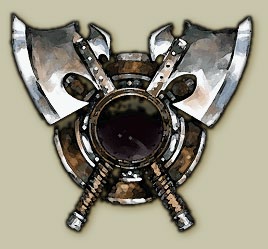| Damage and Repair
See also: Strength
and Durability Calculator
 BREAKAGE BREAKAGE
It makes sense that the items we use in combat would
decrease in integrity over time and may even break.
This type of natural degradation will affect both weapons
and armor and will open the doors for the creation of
more items that have special effects to them, like critical
weighting or padding. Breakage can be broken down into
three main areas: clash, damage, and repair. While most
weapons will be easily repairable, it is important to
understand these three areas and how they affect your
equipment.
CLASH
Understanding breakage begins with the initial combat
scenario we experience while hunting. When someone swings
a weapon and it connects with a target that is wearing
armor in that area, there is always a clash between
the weapon and the armor. When we say "connect,"
we mean that the end result of the combat roll is greater
than 100.
Example:
An Arachne servant swings an invar falchion at
you!
AS: +167 vs DS: +165 with AvD: +35 + d100 roll: +97
= +134
... and hits for 14 points of damage!
Quick slash to your upper left arm!
Just a nick.
Invar falchion clashes with reinforced leather!
[STR/DU: 80/175 vs. 35/270, d100(Open)= 120]
If the attacker does not succeed in hitting the target,
there is always a chance that he or she will instead
strike the defender's weapon or shield. This type of
clash can also result in a connection. It is important
to note that there are a few creatures who do not have
visible armor, but whose skin is as tough as armor (i.e.
stone gargoyles or mein golems), and there will be clashes
when they are hit as well. Once a clash takes place,
we can assess the damage done, if any, to the equipment.
DAMAGE
Every combat item has a Strength, Durability, and an
overall Integrity.
Example:
> appraise my leather
> Careful examination indicates that "some reinforced
leather" has a strength of 35 and a durability
of 270. You determine the current state of the reinforced
leather to be at 99.25% integrity.
Strength is a measure of how strong the item is, and
is also used in comparison to whatever the item is clashing
with. It generally has a number between 0 and 99, with
99 being stronger. Durability is a measure of how well
the item resists breakage and is used in comparison
to an open roll. It has a number between 0 and 999,
with 999 being more durable. Integrity is a modifier
to Strength and Durability that simulates wear and tear
on an item. This number is shown as a percentage between
.01% and 99.99%. When a clash occurs, the strength of
the two items is compared, each modified by the item's
Integrity. The item with the lower Strength is the one
that has the chance of breaking.
Example:
In the above example with the invar falchion and the
reinforced leather, only the reinforced leather has
a chance of breaking, unless the falchion were at less
than 43.7% integrity, which would cause its effective
strength to be less than 35.
If Item A has a Strength of 90 and an Integrity of
90.00%, and Item B has a Strength of 85 and an Integrity
of 99.99%, only Item A has any chance of breaking in
a clash. This is because Item A has an Effective Strength
of 81 (90*90%), while Item B has an Effective Strength
of very slightly less than 85. Once we've determined
which item is weaker, then there is an open roll made.
Whether or not an item breaks depends on the item's
durability vs. the open roll (d100).
Example:
In the example above, the open roll against the leather
was only 120 versus a durability of 270, so no break
would occur. If however, the leather only had a durability
of 100, you would see:
Invar falchion clashes with reinforced leather!
[STR/DU: 80/175 vs. 35/100, d100(Open)= 120]
The reinforced leather shreds and is rendered
utterly useless!
REPAIR
There are two types of repair - Integrity and Catastrophic.
Integrity: If your combat item is down to 90%
Integrity, you will want to get it fixed because it
will more likely be the weaker item in a clash and it
will be easier to break. Integrity can either be repaired
by taking the item to the NPC repairer, found in every
town, or it will be possible to buy repair kits and
the item can be repaired by you or another player. A
player's skill in repairing is directly related to their
skill in that item. For example, if you are trying to
repair your shield, your shield use skill will be taken
into account. The only other modifier to player repair
will come from the Forging skill and will only be used
to modify weapons.
Catastrophic: A catastrophic repair would need
to be done on an item whose Integrity has reached 0%.
If an item is catastrophically broken, only an NPC repairer
may fix it. (In most cases, the NPC need not be a GM.
There will be automated NPCs available at all times.)
The price of repair will be released in the coming
months, so please stay tuned to this page and the GemStone IV Forums for updates and additional information. Please
note that it is very reasonably priced, but the exact
numbers are not available for release at this time.
NOT REPAIRABLE
The number of items that exist today that will not be
repairable will be few and far between. Eventually,
merchants will have the ability to create amazing combat
items that will not be expensive, but will break easily.
This allows for more of a variety in combat items throughout
Elanthia.
|



 BREAKAGE
BREAKAGE